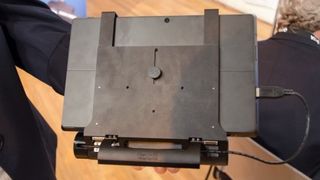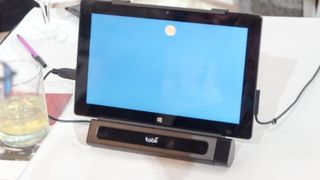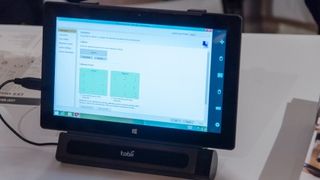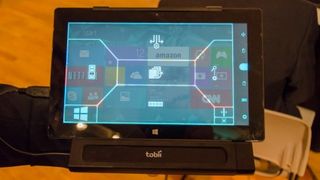Early Verdict
Pros
- +
Sturdy Construction
- +
Intuitive eyes-only control
- +
Easy to learn
Cons
- -
Extremely expensive
- -
Only works with Windows 8 and 8.1
Why you can trust TechRadar
The ways in which we can control our devices is on a steady rate of evolution. First we went from keyboards and mice to touchscreens, and now we're twiddling our fingers in the air with the Leap Motion. Tobii hopes to bring the next revolution with its EyeMobile device that lets users visually tap on hardware with only their peepers at them.
At a recent CES Unveiled NY event night we got some hands-on, or rather eyes-on time with the Tobii EyeMobile eye-tracking device.
To the average user it might just be a novelty to control the tablet with their gaze, but for people who are paralyzed or have disabilities that make it difficult for them to use their arms, the EyeMobile could be a valuable tool in using the technology.
That said, all this eye-tracking wizardry comes at a steep price of $3,245 (about £2,020/AU$3,483), a price that includes a mount and Surface Pro. The eye-tracking device itself costs $1,995 (about £1,242/AU$2,141) and another $350 (about £219/AU$375) for the bracket. Now that you've spewed your drink everywhere, let's see how it really works.
Design

The Tobii EyeMobile we played with was strapped onto a Surface Pro. The metal bracket adds a lot of bulk and armor to the Windows tablet, but it's also meant to be attached to a variety of wheelchairs, bedside mounts and in-vehicle mounts. It also comes with a built-in stand that makes it easy to set up on any table.
The EyeMobile unit, which is about the size of a frankfurter, sits at the bottom of the cradle. Beneath the shiny black plastic on the sensor bar there are two infrared cameras that track the location of your eyes.

The device connects via USB to any Windows tablet that runs the full version of Windows 8 and Windows 8.1 (sorry RT users). This also means users can pop the EyeMobile out of the frame and connect it to a regular computer for the same experience on their laptop or PC. Meanwhile, the bracket can also support a multitude of tablet sizes, from seven to about 13 inches.
Software

When we first sat down and started glaring at the EyeMobile, we had to run a calibration test. This prompted a quick "follow the orange dot" test as it zoomed to nine positions starting from the top left corner and ending at the bottom right. After the calibration, the application creates a viewing pyramid so you don't have to worry about keeping your head perfectly still.
As for the user control application itself, Tobii runs a custom overlay on top of Windows 8. The interface starts with a black and blue bar that sits on the right side of the screen. From here, we could select any number of look-and-pick options for commands such as clicking, zooming and scrolling.

The EyeMobile basically has eye-gaze equivalents to every gesture control option built into Windows 8. We could also access options to right click, type with the keyboard, open recent apps, go back to the start screen and open the charms bar.
But before we could actually select anything, glancing over to the right menu bar and picking an action icon was required. It's a bit of an added hassle, but a necessary step to prevent accidental clicks on every single thing we were looking at. Luckily, our eyes move faster than our hands.

After a few minutes of using the device and diving into the settings to fine tune the sensitivity and click speed, we got the hang of the control method, and it seemed intuitive. Scrolling with our eyes while reading felt especially natural because the device follows your eyes as you read down the page while it slowly raising the line you're reading to the center of the screen.
Other then tapping on tablets for something to happen, using the EyeMobile really isn't that different in comparison since we already select options and parts of the screen we want to look at with our eyes first.
Early Verdict

Tobii's EyeMobile technology still has some early hitches to it and for a fairly astronomical price, it isn't exactly something every user needs. But for the disabled and paralyzed, it's a practical way of using electronics without needing to tap and touch with your hands.
Like all software, Tobii says it's continuing to develop new applications. One company representative said future apps include gaming; the company recently tested the device with StarCraft II, which allowed players to easily access the mini map without having to take their hands off the keyboard.
The idea may not be fully developed or affordable today - but the technology is getting there, and it's certainly something to look forward to.
Kevin Lee was a former computing reporter at TechRadar. Kevin is now the SEO Updates Editor at IGN based in New York. He handles all of the best of tech buying guides while also dipping his hand in the entertainment and games evergreen content. Kevin has over eight years of experience in the tech and games publications with previous bylines at Polygon, PC World, and more. Outside of work, Kevin is major movie buff of cult and bad films. He also regularly plays flight & space sim and racing games. IRL he's a fan of archery, axe throwing, and board games.
What is a hands on review?
Hands on reviews' are a journalist's first impressions of a piece of kit based on spending some time with it. It may be just a few moments, or a few hours. The important thing is we have been able to play with it ourselves and can give you some sense of what it's like to use, even if it's only an embryonic view. For more information, see TechRadar's Reviews Guarantee.


